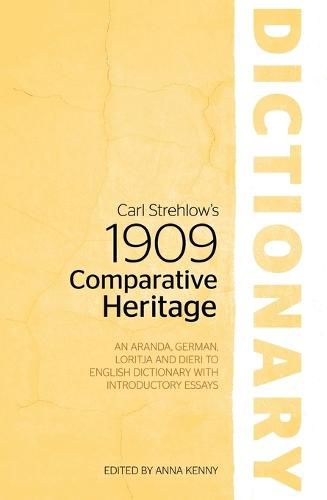Readings Newsletter
Become a Readings Member to make your shopping experience even easier.
Sign in or sign up for free!
You’re not far away from qualifying for FREE standard shipping within Australia
You’ve qualified for FREE standard shipping within Australia
The cart is loading…






Strehlow’s comparative dictionary manuscript is a unique item of Australian
cultural heritage, it is a large collection of circa 7,600 Aranda, 6,800
Loritja (Luritja) and 1,200 Dieri to German entries compiled at the beginning
of the twentieth century at the Hermannsburg Mission in central Australia. It
is an integral part of Strehlow’s ethnographic work on Aboriginal cultures
that his German editor Baron Moritz von Leonhardi published as Die Aranda- und Loritja-Stamme in Zentral-Australien (Strehlow 1907-20) in Frankfurt. Strehlow and his editor
had planned to publish a language study that included this comparative
dictionary, but it remained unpublished until now due to a number of
complicated historical and personal circumstances of the main characters
involved with the dictionary.
Strehlow’s linguistic work is historically and anthropologically
significant because it probably represents the largest and most comprehensive
wordlist of Indigenous languages compiled in Australia during the early
stages of contact. It is an important primary source for Luritja and Aranda
speakers. Both languages are spoken in homes and taught in schools in central
Australia.
The reasons for presenting this work as a heritage dictionary-that is, as
an exact transcription of the original form of the handwritten manuscript-are
to follow the Western Aranda people’s wishes and to maintain its historical
authenticity, which will prove to be of great use to both Indigenous
people and scholars interested in language.
$9.00 standard shipping within Australia
FREE standard shipping within Australia for orders over $100.00
Express & International shipping calculated at checkout
Strehlow’s comparative dictionary manuscript is a unique item of Australian
cultural heritage, it is a large collection of circa 7,600 Aranda, 6,800
Loritja (Luritja) and 1,200 Dieri to German entries compiled at the beginning
of the twentieth century at the Hermannsburg Mission in central Australia. It
is an integral part of Strehlow’s ethnographic work on Aboriginal cultures
that his German editor Baron Moritz von Leonhardi published as Die Aranda- und Loritja-Stamme in Zentral-Australien (Strehlow 1907-20) in Frankfurt. Strehlow and his editor
had planned to publish a language study that included this comparative
dictionary, but it remained unpublished until now due to a number of
complicated historical and personal circumstances of the main characters
involved with the dictionary.
Strehlow’s linguistic work is historically and anthropologically
significant because it probably represents the largest and most comprehensive
wordlist of Indigenous languages compiled in Australia during the early
stages of contact. It is an important primary source for Luritja and Aranda
speakers. Both languages are spoken in homes and taught in schools in central
Australia.
The reasons for presenting this work as a heritage dictionary-that is, as
an exact transcription of the original form of the handwritten manuscript-are
to follow the Western Aranda people’s wishes and to maintain its historical
authenticity, which will prove to be of great use to both Indigenous
people and scholars interested in language.